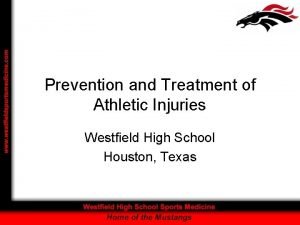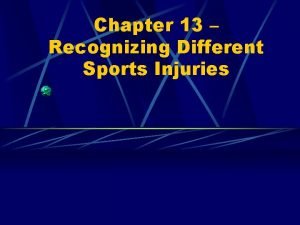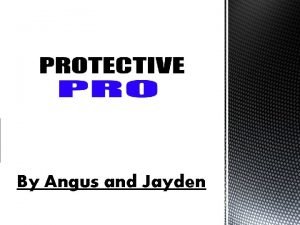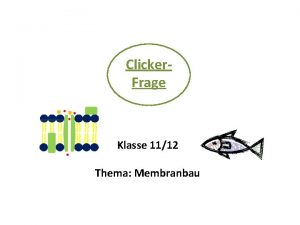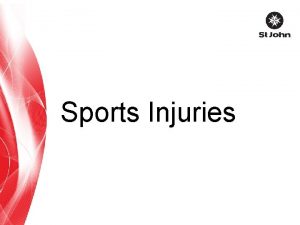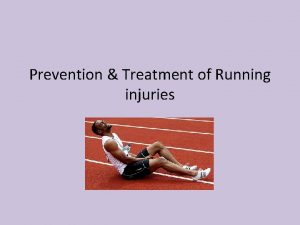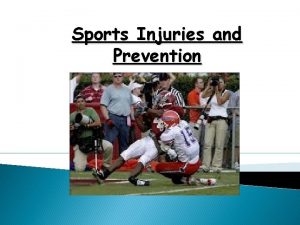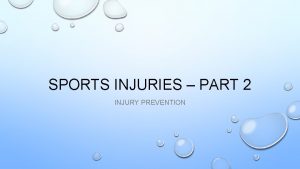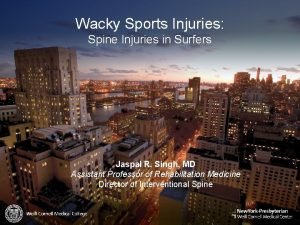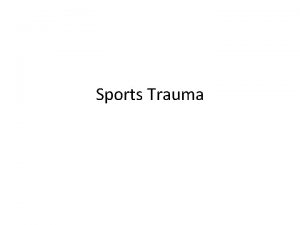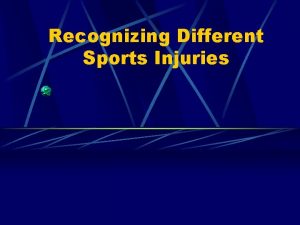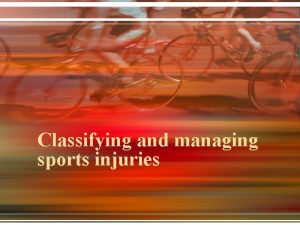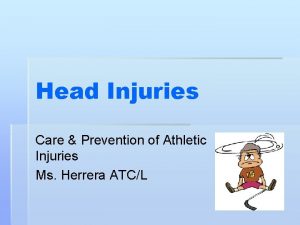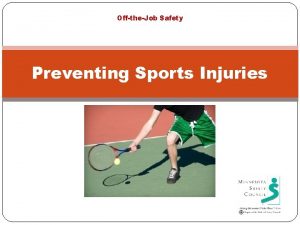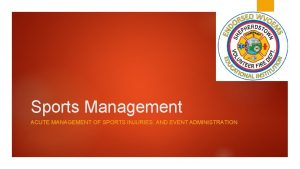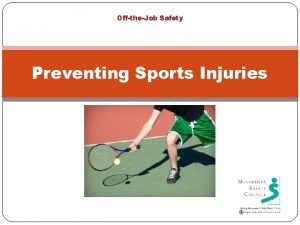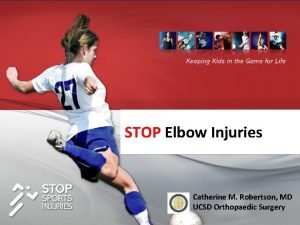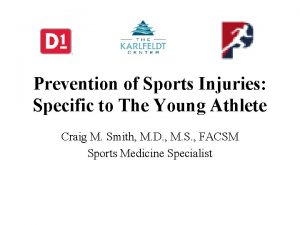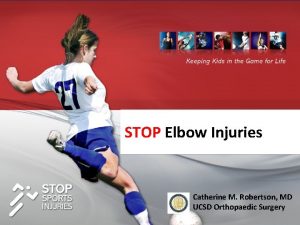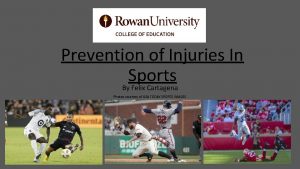Sports Injuries Treatment Prevention Active for Life 1112

































- Slides: 33

Sports Injuries, Treatment & Prevention Active for Life 11/12 - Inch

What are Sport Injuries? Sports injuries result from acute trauma or repetitive stress associated with athletic activities Sport injuries can affect bones and joints or soft tissues, such as ligaments, muscles and tendons

Categories & Cause of Injuries Direct & Indirect– external or internal force Soft & Hard tissue – skin, muscles, tendons, ligaments, bones, cartilages Overuse – sustained form continuous or repetitive stress, incorrect technique or equipment or over-training


Some factoids… About 95% of sports injuries are minor soft tissue traumas The most common sports injury is a bruise (contusion) - caused when blood collects at the site of an injury and discolours the skin Sprains (mostly wrist & ankle) account for 35% of all sports injuries Fractures account for 5 -6% of all sports injuries Stress fractures are especially common in dancers, long-distance runners and people who perform repetitive motions over long periods of time

Types of Injuries Acute vs. Chronic Both types usually involve muscle & bone • Acute Result from a collision or sudden twist Examples = Sprains/Strains, Contusions, Fractures • Chronic / Overuse Repetitive, small injuries due to repeat motions Increased today as children strive for excellence at younger ages Examples = Pitching a baseball, Running cross country, Freestyle Skiing, Swimming

Examples of Common Injuries v. Overuse or Chronic Injury Bursitis Tendinitis Stress Fractures Shin Splints IT-Band pain/PFS v. Acute Traumatic Injuries Laceration Abrasion Sprains Strains Dislocations / Subluxations Fractures

Chronic injuries are caused by continuous stress on a body part over a long time. Here are some common chronic injuries: tennis elbow golfers elbow shin splints. Chronic injuries can be caused by training too hard, not allowing time for recovery, poor footwear and bad technique.

Acute injuries There are three main causes: 1. Collisions with opponents or obstacles. 2. Being struck by an object. 3. Falling from a height or at speed. © EMPICS Ltd Acute injuries occur when there is sudden stress on the body.

Hard and soft tissue injuries Hard tissue injuries are bone injuries. Soft tissue injuries involve damage to skin, muscles, tendons, ligaments or cartilage.

Closed injuries Bruises occur when small blood vessels are damaged by an impact or sudden wrenching movement. This causes bleeding beneath the skin, leading to swelling and discolouration. Strains – strained/pulled muscles result from muscles being suddenly and forcefully overstretched. This tears the muscle fibres, usually where they attach to the tendon. The muscle is painful and its strength is reduced. Bruises and strains should be treated with ice to reduce the swelling.

Sprains are different to strains – they involve ligaments rather than muscles and tendons. Sprains occur when ligaments at joints get stretched and torn. A sharp twist of the foot can give you a sprained or twisted ankle. Severe sprains result in torn ligaments. Sprains are more serious than strains, and result in considerable pain and loss of function at the joint. The symptoms are similar to a fracture or dislocation. Sprains should be treated with ice and rest.

Ankle Injuries v Anatomy The Ankle is a Hinged Joint Distal Tibia/Fibula/ Medial & Lateral Malleolus/Talus 3 Planes of Motion v. Dorsiflexion-Plantar Flexion v. Inversion-Eversion v. Abduction-Adduction

Ankle Sprain – Severity Guide GRADE III Mild Moderate Severe Some Tearing of Ligamentous Fibers & Loss of Function Complete Rupture of Ligaments. Loss of Function & Instability of the Joint

Ankle Sprain – Severity Guide

Achilles Tendinitis v Achilles Tendon - Poor Capacity to Repair v Common Overuse Syndrome v Direct Trauma Can Lead to Rupture v Clinical Presentation Pain Stiffness v Conservative Treatment P-RICE-MM Daily Stretching Orthotics / Heel Lifts

Cartilage/Meniscal tear of the knee Cartilage/Meniscus aids friction free movement at the knee joint and provides some shock absorption. Cartilage can tear if the knee is twisted excessively. A cartilage tear is a serious injury. The knee will be painful, may ‘lock’ and will swell. cartilage

Lower Extremity Injuries - Knee Normal Knee – Posterior & Anterior Views

Knee – Ligamentous Injuries v Function Attaches Bone to Bone Stabilizes Knee v Mechanism of Injury Torsional Injury Often with Direct Blow v Anterior & Posterior Cruciate Ligaments (ACL / PCL) - tearing v Medial & Lateral Collateral Ligaments Grade 1 Grade 2 Grade 3

ITB Friction Syndrome & Patellofemoral pain syndrome (PFPS) v Iliotibial Band Provides Lateral Stabilization to Knee Joint v Overuse Syndrome From Excess Friction • PFPS also known as patellar overload syndrome and runner's knee v Conservative Treatment RICE • Characterized by knee pain ranging from severe to mild discomfort (felt behind, at or above knee) v Surgical Intervention Targeted to Remove Impinging Posterior Fibers Rare • RICE & Exercise therapy

Upper Extremity Injuries – Shoulder Impingement Syndrome Rotator Cuff Injury v Multifactoral Mechanism of Injury Overuse Syndrome v Clinical Presentation Pain Over the Lateral and Anterior Shoulder Radiating Into Deltoid Initially Pain Occurs With Activity Especially Overhead Motions – Progressing to Pain at Rest Decreased and Painful Range of Motion May Feel Shoulder Catch

Dislocation A dislocation occurs when a bone is pulled or twisted out of place at a joint. When the shoulder is dislocated, the humerus is pulled out of the socket on the scapula. Dislocations are very painful. They require hospital treatment to move the bone back into position. The ligaments and tissue around the joint can take a long time to recover.

Hard tissue injuries are bone fractures – the bone either cracks or breaks. Fractures lead to: bruising and swelling pain due to nerve damage the limb or area of the body where the break is becomes immobile if it is a bad fracture, the area will look obviously deformed. Shin splints are a form of partial fracture caused by repeated stress.

Fractures can be open (simple) or closed (compound). A simple or closed fracture means that the bone is cracked but the skin is not broken. A compound or open fracture means that the skin is broken and the bone is sticking out. Open fractures are more serious. They usually involve blood loss.

Shin Splints / Stress Fractures v Overuse Syndrome v Micro Fractures Develop in Tibia v Diagnostic Testing X-Rays Rule Out Fracture Bone Scan Differential Diagnosis of Stress Fracture v Conservative Treatment RICE Orthotics Prevention Shin splints are pains in the lower leg, caused by continuous stress over a long period of time. Either the tendons around the tibia become inflamed, or ‘stress fractures’ develop – these are cracks along the length of the bone. Shin splints should be treated with ice and plenty of rest. Cushioned footwear and special insoles can help to prevent the injury returning.

INJURY TREATMENT (Tx) - R. I. C. E. Whenever there is any injury to bones, joints, ligaments muscles or tendons, blood vessels will be damaged. Broken blood vessels mean that blood leaks into tissues around the injury. This will lead to swelling, bruising and pain. To combat the effects of this, you should follow the R. I. C. E method of treatment: R – Rest/Reduced Activity I – Ice C – Compression E – Elevation

‘Do NO HARM’ - Avoid the HARM-ful factors for 72 hours after the injury H - Heat increases the bleeding at the injured site. Avoid hot baths and showers, saunas, hot water bottles, heat packs and liniments. A - Alcohol increases bleeding and swelling at the injury site, and delays healing. It can also mask the pain of the injury and its possible severity, which may result in the player not seeking treatment as early as they should. R – Running/any form of exercise will cause further damage. A player should not resume exercise within 72 hours of an injury unless a medical professional says it is alright to exercise. M- Massage causes an increase in bleeding and swelling, and should be avoided within 72 hours of the injury. If the injury is massaged within the first 72 hours, it may take longer to heal.

Injury PREVENTION v Proper dynamic warm-up to heat muscles prior to work v Utilize proper technique when performing exercises & use equipment properly v Wear protective equipment designed for the sport – including braces/supports v Incorporate stretching/flexibility component into workout routine to ensure muscles are lengthened and able to go through full ROM v Strengthen core and strengthen supporting muscles to ease load on joints v Treat injuries as they arise – RICE, do no HARM v ROLL-out – Myofascial release

Myofascial Release – Using Foam Rollers With the advent of foam rollers, athletes and fitness enthusiasts can improve their workouts and decrease their risk of injury. Foam rollers provide many of the benefits of a message therapist, but from the comfort of one’s own home and with this inexpensive piece of workout equipment.

What is Myofascial Release? Myofascial release is the application of low-intensity forces to soft tissues over a long period of time. The purpose is to allow contracted muscles to relax, which improves blood flow and nutrient flow to the area. The effect is that muscles operate with smoother motion because of reduced internal rubbing or friction.

At least 6 KEY benefits to FOAM ROLLING 1) Increased Blood Flow - Myofascial release via foam rolling stretches and loosens muscles. By applying force to your muscles and connective tissue over time, blood is squeezed out and replaced by a flood of fresh blood (carrying oxygen and glucose). 2) Improved Movements - Better hydrated and looser muscles move past one another with less friction. This means that during a workout, movements are smoother and muscles are less likely to be pulled or damaged. 3) Better Range of Motio - Properly stretched and lubricated muscles have a larger range of motion and this means more muscle can be recruited in a given workout, leading to a more effective routine. 4) Decreased Risk of Injury - Self-massage increases circulation throughout the body. Better circulation means a better ROM and more effective body movements. This reduces the chance of injury because coordination of the body is improved and there is less likelihood of an improper movement leading to injury. 5) Decreased Recovery Time - After a workout, muscles and joints become sore because of the build-up of waste products such as lactic acid. When performed post-workout, rolling acts to wash the acid away by recruiting fresh blood and nutrients to the fatigued muscle groups. Foam rolling is an effective means to draw blood to an already injured area as well. 6) Faster Results - All of the positives of myofascial release lead to a decreased recovery time and a lower chance of injury. If an athlete stays healthy over time while being able to exercise more frequently, then they will inherently produce faster results.


 Primary prevention secondary prevention tertiary prevention
Primary prevention secondary prevention tertiary prevention Westfield sports injuries
Westfield sports injuries Chapter 11 assessment and evaluation of sports injuries
Chapter 11 assessment and evaluation of sports injuries Chapter 13 worksheet recognizing different sports injuries
Chapter 13 worksheet recognizing different sports injuries Sports injuries angus, on
Sports injuries angus, on How are sports injuries classified and managed
How are sports injuries classified and managed Scxi-1112
Scxi-1112 Igmpv
Igmpv 1112 frage
1112 frage Eng 1112
Eng 1112 Lashn
Lashn English 1112
English 1112 Indoor sports and outdoor sports
Indoor sports and outdoor sports 3 to 8 decoder truth table
3 to 8 decoder truth table Membrane structures that function in active transport
Membrane structures that function in active transport Primary active transport vs secondary active transport
Primary active transport vs secondary active transport Fspos vägledning för kontinuitetshantering
Fspos vägledning för kontinuitetshantering Typiska novell drag
Typiska novell drag Tack för att ni lyssnade bild
Tack för att ni lyssnade bild Ekologiskt fotavtryck
Ekologiskt fotavtryck Varför kallas perioden 1918-1939 för mellankrigstiden
Varför kallas perioden 1918-1939 för mellankrigstiden En lathund för arbete med kontinuitetshantering
En lathund för arbete med kontinuitetshantering Adressändring ideell förening
Adressändring ideell förening Tidbok
Tidbok Sura för anatom
Sura för anatom Förklara densitet för barn
Förklara densitet för barn Datorkunskap för nybörjare
Datorkunskap för nybörjare Stig kerman
Stig kerman Hur skriver man en debattartikel
Hur skriver man en debattartikel För och nackdelar med firo
För och nackdelar med firo Nyckelkompetenser för livslångt lärande
Nyckelkompetenser för livslångt lärande Påbyggnader för flakfordon
Påbyggnader för flakfordon Arkimedes princip formel
Arkimedes princip formel Svenskt ramverk för digital samverkan
Svenskt ramverk för digital samverkan

